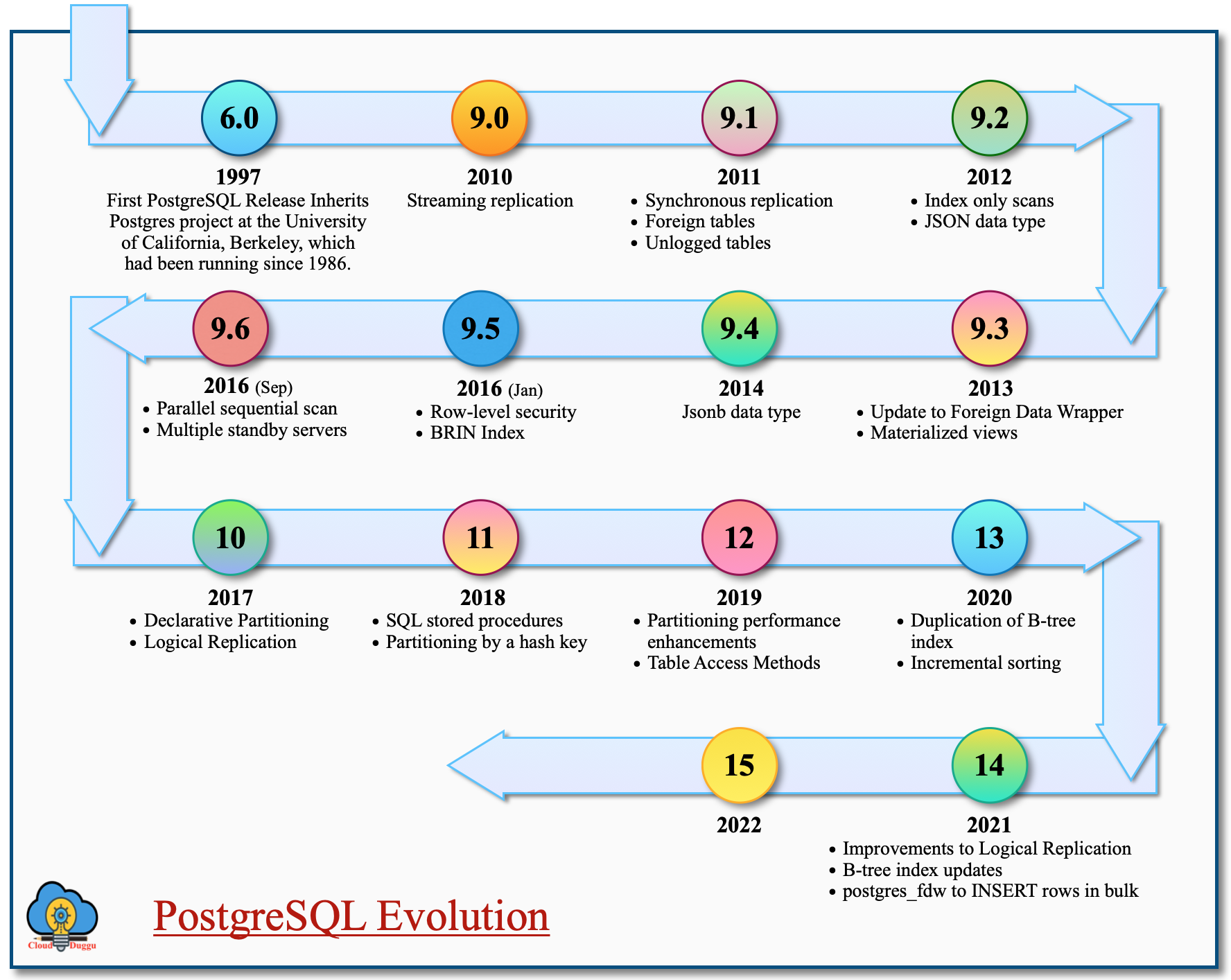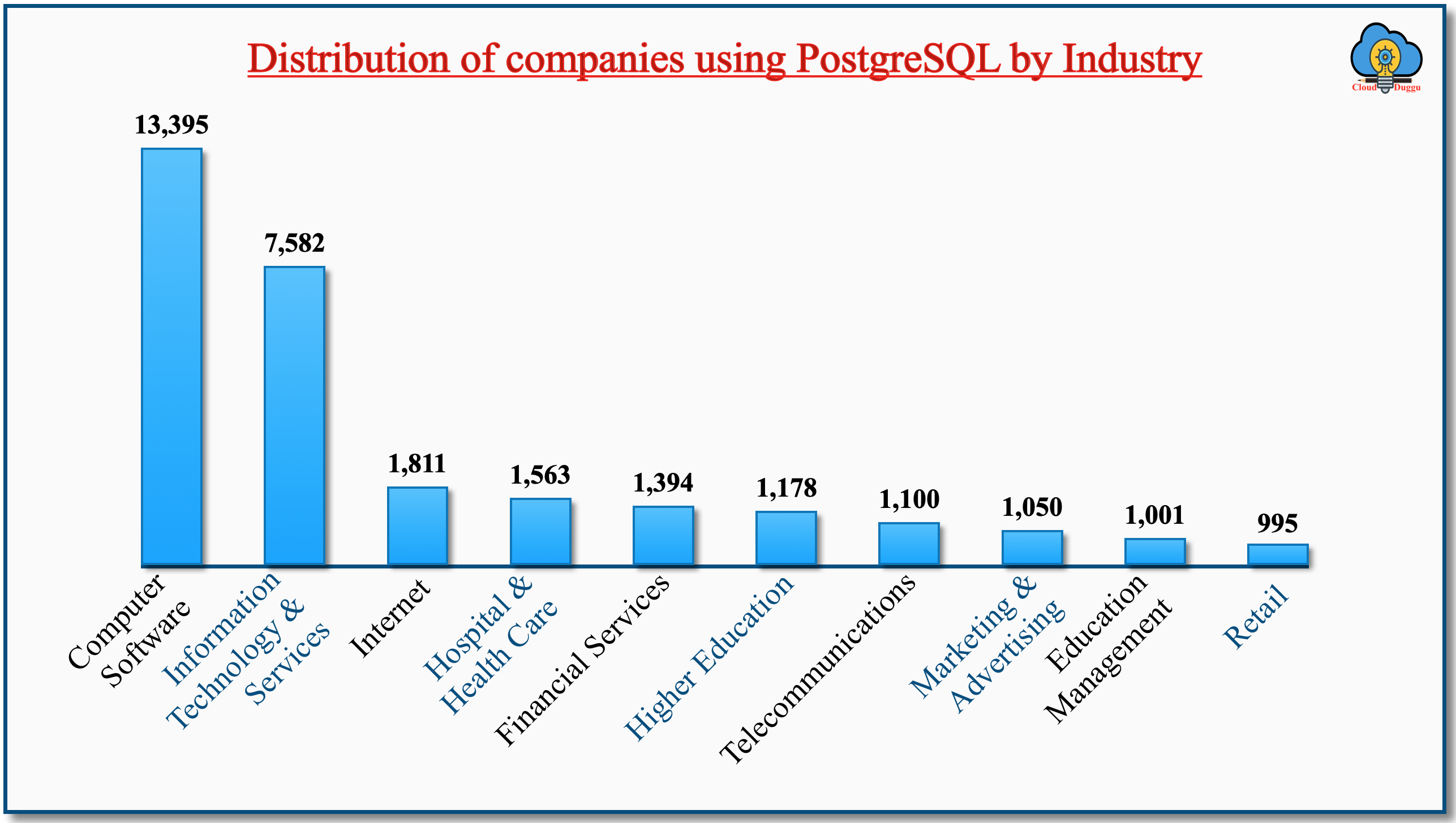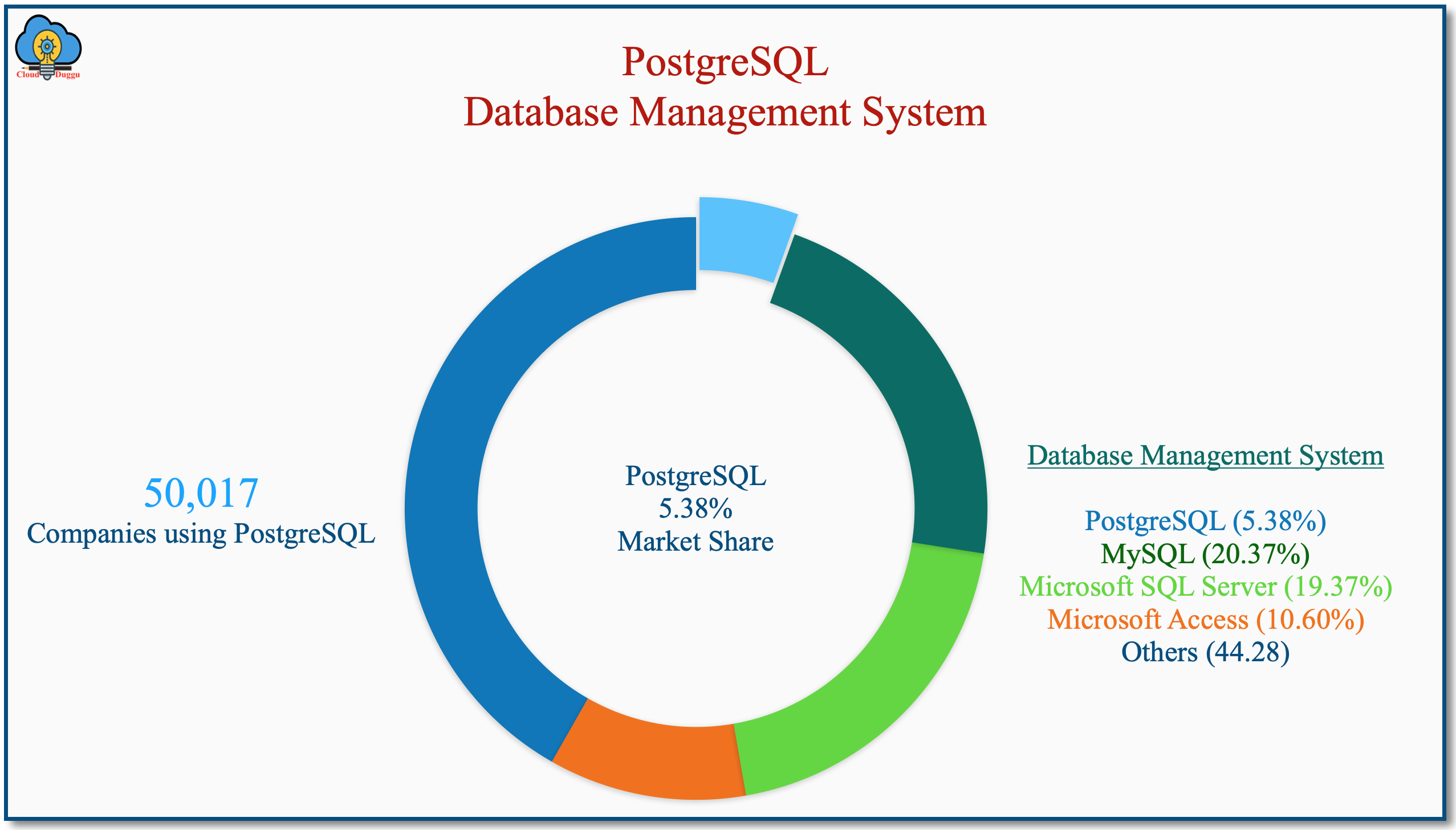What is PostgreSQL?
PostgreSQL is the world-famous freeware and an advanced object-relational database management system (ORDBMS) that was developed by the University of California at Berkeley Computer Science Department. PostgreSQL is widely used in many organizations and startup companies in their production, development, business, and mobile applications. The object-relational database features provide the facility to create user-defined objects, data types, functions, indexes, and operators. The JSON support facility allows PostgreSQL to go for a schema-less structure in the SQL database. PostgreSQL is designed to handle a wide range of concurrent workloads starting from a single node to a data warehouse system. PostgreSQL can be installed on all major operating systems which are Linux, macOS, Windows, BDS, Solaris, and an ACID compliant database.
Why PostgreSQL?
PostgreSQL is a feature-rich database that was developed to help the database administrators to protect and maintain data integrity, developers create an application without worrying about the dataset size. It's a freeware and extensible database solution in which users can define their custom data types, create custom functions, and create new codes using various programming languages without recompiling the database code.
The following are some of the important reasons to use PostgreSQL.
- PostgreSQL supports almost all data types such as Primitives data types which includes integer, numeric, boolean, string, etc the Structured data types which include Date/time, timestamp, interval, array, Documents Data types such as JSON, XML, Hstore, and customized user-defined data types.
- To maintain Data Integrity, PostgreSQL supports all ACID properties that help to implement all business logic in the database.
- PostgreSQL achieves the Performance and Concurrency by defining the advanced level of indexing methods such as B-tree, Multicolumn, Expressions, KNN Gist, Partial, Bloom filters, SPGist, multi-columns stats, GiST, BRIN, GIN, and so on.
- PostgreSQL maintains the Write-ahead Logging (WAL) for the data protection and point in time recovery using Asynchronous, Synchronous replications.
- To maintain security between client and database, PostgreSQL uses the advanced level of Authentication methods such as SSL encryption, LDAP, SCRAM-SHA-256, GSSAPI Certificate, and SSPI to secure the connection from any attack.
- PostgreSQL supports the native data types of JSON, Hstore, XML, and C-store to convert the PostgreSQL database into a NoSQL database.
- PostgreSQL supports Geographic Information System by adding the PostGIS extension to run the location query in SQL.
Features of PostgreSQL
PostgreSQL is the most advanced open-source object-relational database management system which is loaded with many important features. The following are some of the important features of the PostgreSQL database.
1. PostgreSQL Data Types
PostgreSQL supports different types of data types to perform various operations. The major Data types of PostgreSQL are Primitives which contain (Integer, Numeric, String, Boolean), Structured that contains (Date-Time, Array, Range- Multirange, UUID), Document that contains (JSON-JSONB, XML, Key-value (Hstore), Geometry that contains (Point, Line, Circle, Polygon) and the Customized data types defined by the users.
2. Data Integrity
To maintain the best Data Integrity, PostgreSQL support all standard constraints such as Primary Keys, Foreign Keys, UNIQUE, NOT NULL, and Exclusion Constraints.
3. Disaster Recovery and Reliability
PostgreSQL uses the Write-ahead Logging (WAL) to store the data and provides the data assurance without losing it. The Asynchronous, Synchronous replication is used to replicate data from one server to another server and the Point-in-time recovery (PITR) mechanism is used to recover the data in case of any data corruption.
4. Best Performance and Concurrency
PostgreSQL uses the advanced level of indexing to boost the performance which is B-tree, Bloom filters, KNN Gist, Covering indexes, GiST, BRIN, SP-Gist, and GIN. The multicolumn statistics, query planner, and index-only scan features provide the optimum performance. The Multi-Version concurrency Control feature provides the control of transactions and the Just-in-time (JIT) feature provides the compilation of expressions
5. Advanced Security
PostgreSQL offers the best level of security to protect the data at the column level and row level. It supports authentication using Multi-factor, LDAP, GSSAPI, SCRAM-SHA-256, SSPI, and many more authentication methods.
6. Highly Extensible
PostgreSQL is highly Extensible by using the Foreign data wrappers to connect with other databases using the SQL interface, the Procedural Languages support that includes Python, PL/PGSQL, and Perl. It also supports the customized storage for the tables and additional extension that includes PostGIS for Geographic Information System support.
7. No Relational Data Support
PostgreSQL supports the native documents data types JSON, XML, Hstore, and Cstore that can be transformed from PostgreSQL into NoSQL Database. These documents' data can be indexed to provide the best speed and access using the SQL query.
History of PostgreSQL
The following is the year-by-year history of PostgreSQL.
1982: PostgreSQL has been developed from Ingres Project. Michael Stonebraker left Berkeley and started working on Ingres Project to make it a proprietary version.
1985: After returning to Berkeley, he started working on the contemporary database systems problem and started a project called post-Ingres.
1986: The whitepaper was published that was showing about the system basis.
1988: The prototype version was published at the ACM SIGMOD Conference.
1989: Version 1 was released to a small group of people.
1990: Version 2 was released by re-writing the system rules.
1991: Version 3 was released by re-writing the system rules to improve the query engine to add support for the multiple storage managers.
1994: The POSTQUEL query language interpreter was replaced by the Berkeley students Yu and Jolly Chen to SQL query language and the new version was created with the name Postgres95.
1996: Marc Fourni from Hub.org Networking Services provided the first non-university development server for open source development and the project name changed to PostgreSQL to reflect its support of SQL language. This year October 22, the PostgreSQL.org website was started.
1997: This year January 29, the first version of PostgreSQL was released and since then the PostgreSQL is maintained by the PostgreSQL Global Development Group in which there are many developers and volunteers are involved around the globe.
1998-2001: The new feature Join syntax Controls, MVCC, GUC, and Procedural Language Loader were added.
2002-2006: PostgreSQL Version 7.2 and 8.2 were released that includes features like dblink, roles, Schema support, and so on.
2009: PostgreSQL Version 8.4 was released.
2010: PostgreSQL Version 9.0 was released.
PostgreSQL Evolution
The following figure shows the Evolution of PostgreSQL and its major features.

PostgreSQL Advantages
The following are some of the major advantages of PostgreSQL.
- PostgreSQL is an open-source freely available Object-relational database management system. Its source code can be used to modify, update, and customized per business need.
- The WAL(write-ahead logging) feature of PostgreSQL makes it a fault-tolerant database.
- PostgreSQL supports the ACID(Atomicity, Consistency, Isolation, Durability) properties.
- PostgreSQL has big community support for its development and enhancement.
- The Geographic support of PostgreSQL makes it use of Geographical based data service and support.
- PostgreSQL is easy to learn and use.
- PostgreSQL can be installed on Windows or Linux systems.
- The maintenance and administration of PostgreSQL are very less.
- The Multi-Version Concurrency Control(MVCC) advanced technique of PostgreSQL helps to improve the database performance in the multi-user environment.
- PostgreSQL supports the online/hot backups that can be performed during normal business hours as well.
- PostgreSQL supports advanced programming languages and protocols which include Python, Java, Perl, .Net, Go, Ruby, C/C++, Tcl, and ODBC.
PostgreSQL Disadvantages
The following is the list of some of the major disadvantages of PostgreSQL.
- The installation of PostgreSQL can be a bit challenging at the beginner level.
- PostgreSQL is managed by an open community and not by any Organization.
- Despite having a full feature, PostgreSQL faced much trouble to make its name.
- The number of resources who know PostgreSQL is less in the market.
Difference Between PostgreSQL and MySQL
Let's see some of the major differences between PostgreSQL and MySQL.
| PostgreSQL | MySQL |
|---|---|
| PostgreSQL is an open-source database solution. | MySQL is also an open-source database. |
| PostgreSQL is developed in the C language. | MySQL is written in C/C++. |
| The licensing of PostgreSQL comes under PostgreSQL License. | The licensing of MySQL comes under GPLv2 or proprietary. |
| PostgreSQL is developed and maintained by the PostgreSQL Global Development Group. | MySQL is developed and maintained by the Oracle Corporation. |
| The operating system supported by PostgreSQL is macOS, Windows, Linux, FreeBSD, and OpenBSD. | The operating system supported by MySQL is macOS, Windows, Linux, FreeBSD, and OpenBSD |
| PostgreSQL is required in those cases where complex query execution is required for intense read and write operations. | MySQL is widely used in web-based applications in which there is a database is required to perform the transaction. |
| PostgreSQL uses the SLL for secure connection and encryption. | MySQL comes with many inbuilt security features that make it secure. |
| PostgreSQL uses the master-slave replication to perform the replication. | The master-slave replication is also performed in MySQL to achieve the replication. |
| PostgreSQL uses the PgAdmin GUI tool. | MySQL uses the MySQL Workbench tool to perform administrative tasks. |
| A single storage engine is used in PostgreSQL. | Multiple storage engines can be used in MySQL. |
Top Industries are Using PostgreSQL
PostgreSQL is used by top Industries in which the major contribution is from Computer Software(27%) and Information Technology and Services(15%).

As of 2022, the PostgreSQL market share in the database management system is 5.38%.

